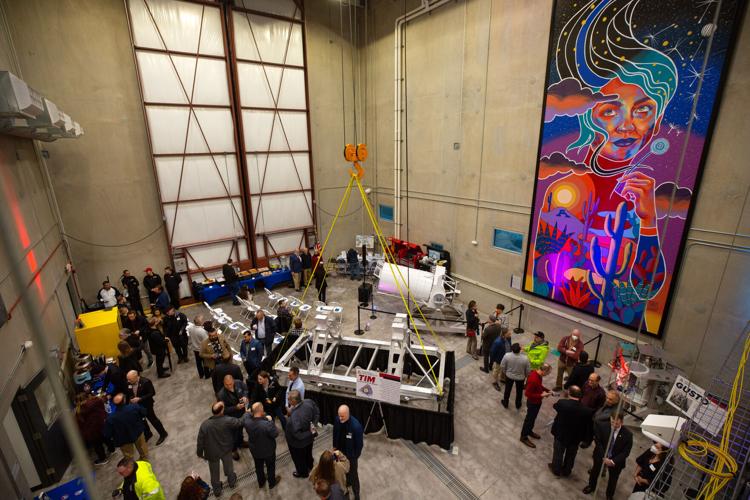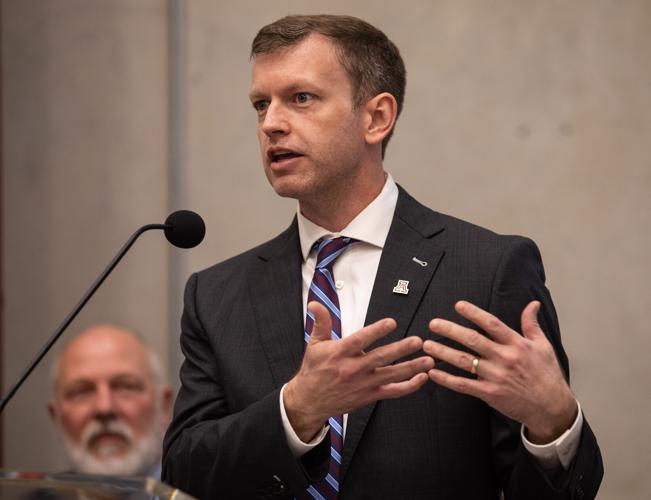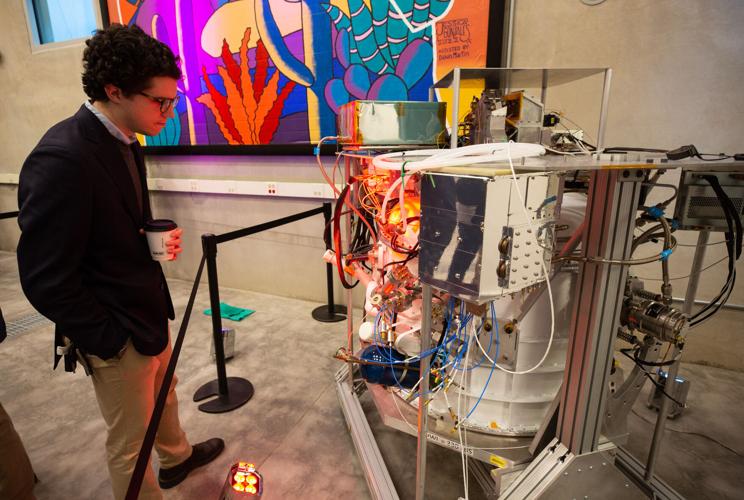University of Arizona space scientists have a new place to ready mission packages for high-altitude balloon flights, with the opening of the school’s Mission Integration Lab on Tucson’s south side.
On Monday, UA officials and supporters christened the 43-foot tall building at the UA Tech Park at The Bridges, which features a high bay to suspend balloon payloads.
The new facility will allow researchers and engineers to build and test hardware for balloon-borne astronomy experiments and missions.
Balloon-borne astronomy fills an important gap between ground-based observatories and space telescopes, allowing deployment of telescopes and other instruments to altitudes where they avoid much of the interference from Earth's atmosphere at a fraction of the cost of space missions.

Prof. Dan Marrone of the UA Department of Astronomy, a researcher pursuing balloon-borne astronomy, at the UA Mission Integration Lab at University of Arizona Tech Park at the Bridges in Tucson on Monday.
The UA must expand its research infrastructure to maintain its ranking among the top schools in the nation for space sciences, said Jeff Kingsley, associate director of the UA’s Steward Observatory.
“The high-altitude balloon experiments are expanding our knowledge and understanding of star formation, life cycles of stars and interstellar media, and other specialized observations unable to be done with a ground-based telescope,” Kingsley told a crowd of about 150 attendees who huddled inside the lab for a ribbon-cutting to avoid the rain.
The lab building features a high-bay area covering 4,500 square feet of floor space, 40-foot-high doors and an overhead crane system with a capacity of 7 ½ tons.
The building, designed by Tucson-based Swaim Associates Architects, was built by Concord General Contracting with foot-thick, prefabricated concrete walls.
Among the current UA projects using the new lab is the Galactic/Extragalactic ULDB Spectroscopic Terahertz Observatory, or GUSTO, a $35-million, NASA-funded long-duration balloon mission planned for launch from Antarctica next year.
Another is Terahertz Intensity Mapper, or TIM, a NASA-funded balloon mission designed to create a giant map of galaxies over 5 billion years of cosmic history.

The instrument module for the GUSTO – Galactic/Extragalactic ULDB Spectroscopic Terahertz Observatory – long-duration balloon mission was on display at the UA Mission Integration Lab at University of Arizona Tech Park at the Bridges in Tucson on Dec. 12.
Facilities like the Mission Integration Lab are critical for testing to avoid costly mission failures, said UA professor Dan Marrone, a co-investigator on TIM.
“This is going to make it so much easier to do missions like this in the future,” Marrone said. “In space missions, you only get one chance, the same with balloon missions, and this facility will help us do it right.”
The UA is investing $4.75 million in the Mission Integration Lab, which will be used by researchers across campus and help attract corporations looking to advance their tech through public-private partnerships.
The new lab will generate new science as well as attract commercial space ventures, said Betsy Cantwell, senior research and innovation.
“This building is the beginning of the commercial space empire we are building in Tucson,” Cantwell said. “When you take that remarkable science at the UA and you build a place that gives that science an opportunity to blossom into new work, whether it’s science or commercial, it provides new jobs and new capabilities for Tucson.
UA President Robert Robbins said the new facility will further strengthen the school’s already formidable space-science capabilities while attracting private commercial partners.
“Because of the science that’s done here, the fundamental discoveries, we can translate that into new commercializable products, and therefore companies from all over the world want to come here and work with us — as we used to say in Texas, we’re sweetening the honey pot, ” he said.
The Mission Integration Lab is the first UA research building to be built at The Bridges, a 365-acre mixed-use development that includes 65 acres of UA property, noted Carol Stewart, vice president of Tech Parks Arizona.
By January, the Springhill Suites by Marriot is expected to open on The Bridges’ south end, and the UA Center for Innovation will soon open a new business incubator at The Refinery, where a new commercial tenant will soon be announced, Stewart said.
“We’re really building that work, live and play environment here,” she said.
The University of Arizona's new test facility for balloon-borne research is taking shape at the UA Tech Park at The Bridges, where also several UA tech agencies are moving into a new building.







